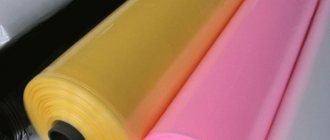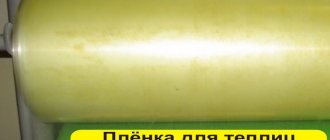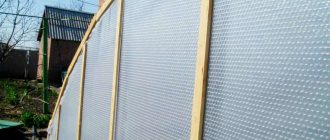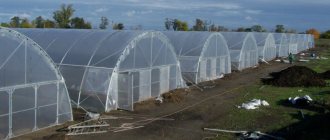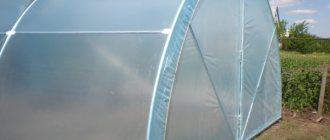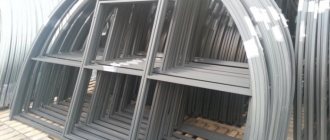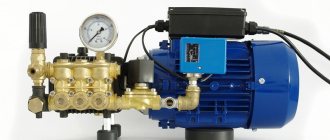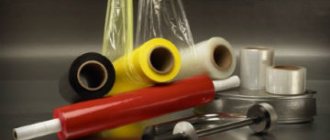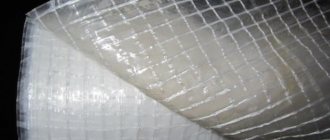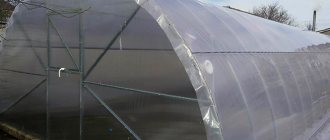The frame of garden greenhouses and greenhouses is most often covered with inexpensive film material. Polyethylene retains heat well and does not allow precious moisture to escape. However, this material, unfortunately, is not very durable and strong. For many manufacturers, this has become an incentive to develop new high-quality films for greenhouses and greenhouses with improved performance characteristics. One of the most popular perennial covering materials among our gardeners has become the Svetlitsa film. The reviews about it online are simply excellent. At the moment, varieties of material of this brand are produced, intended not only for covering greenhouses, but also for mulching the soil, laying the bottom of reservoirs, etc.
Manufacturer
The film "Svetlitsa" was developed by specialists of the LLC "Shar" company. This domestic company was organized more than 20 years ago - in 1991 in St. Petersburg. Its main activity is the development of composite materials with a set of specified properties according to customer specifications, as well as the development of technologies for their production.
Shar LLC specialists conduct various types of research to significantly extend the service life of films under a variety of extreme conditions: elevated temperatures, intense UV radiation, high humidity, etc.
FILM MAGNUS-AGRO
Perennial film " Magnus-Agro " has a maximum width of up to 12 meters. It is produced exclusively from elite brands of Russian, Saudi and metallocene polyethylene using three-layer technology. This formulation makes it possible to achieve maximum strength required for wide-span professional greenhouse complexes.
Agrotema A LLC offers a wide range of high-quality perennial films for wholesale and small-scale (from a roll) buyers at a competitive price. You can buy proven Svetlitsa perennial polyethylene film or Magnus-Agro ultra-wide film with delivery or pickup. For wholesale buyers there is a flexible system of discounts based on the amount of a one-time purchase and on the total turnover for the year.
Varieties
The Svetlitsa film, the reviews of which from domestic consumers are simply excellent, is thus distinguished by truly remarkable qualities. At the moment, several varieties of this material are produced:
- Designed for mulching. Such films can have a variety of colors (green, yellow, black, etc.).
- Hothouse. Can transmit rays of different spectrums.
- For thermal curtains.
- For packing hay. A very durable and elastic variety. It is almost impossible to puncture such a film.
- Waterproofing films. Used as a protective agent in the construction of buildings, construction of reservoirs and sedimentation tanks, etc.
- For steaming the soil.
- Photodestructible films are used in operations such as tree grafting, vineyard mulching, etc.
Combination of materials
When building an unheated greenhouse or to save fuel, the most successful solution would be to combine reinforced film and Svetlitsa. Two layers will allow you to start planting plants in early spring even during the period of severe frosts. From below, the greenhouse is covered with Svetlitsa. To save money, you can choose thinner material. Its task is to prevent the accumulation of condensation dripping onto the plants. Reinforced material is laid on top. Its purpose will be to take on the wind load. It withstands mechanical stress well and also provides ultraviolet stabilization. Both materials have sufficient light transmission for most greenhouse plants.
In combination with Svetlitsa and reinforced film, the service life of the greenhouse is maximized. In addition, it significantly reduces construction costs. Reinforced coatings of even higher thickness are cheaper. As a bottom layer, you can use thin Svetlitsa, the value of which lies in its anti-condensation properties.
Advantages of greenhouse film
This variety is most widespread on the domestic market. The manufacturer lists the main advantages of such material as Svetlitsa greenhouse film:
- Durability. This material can last at least 7 years without being removed from the frame.
- Presence of a hydrophilic surface. Water drains from a structure covered with this material much easier than from a polyethylene one.
- High heat-retaining qualities. At night, under such a film, the air cools much less. Its average temperature is about 4 degrees higher than in a greenhouse covered with polyethylene.
- Ability to stick together under slight pressure. In places where there is an overlap, this film sticks together over time, making the entire structure completely airtight.
- Ability to transmit sunlight perfectly. The illumination of plants under such a film is 20% higher than under polyethylene.
- Flexibility. Thanks to this feature, the film for the Svetlitsa greenhouse is easily stretched onto the frame.
- Frost and hail resistance
Pros and cons of the material based on manufacturer data
The manufacturer highlights the following positive characteristics of its product:
- Does not tend to accumulate condensation on the inner surface.
- Twice the tensile strength, 5 times more wind resistant, transmits 20% more light compared to conventional polyethylene covering film of the same thickness.
- It has increased hydrophilicity. Due to the low contact angle (50°), the condensate becomes smaller and flows in flat drops along the surface, rather than dripping vertically onto the plants.
Film tests were carried out in field conditions. It was tested for heat resistance in Dagestan at thermometer readings of +42 °C and above. Svetlitsa sellers promise its continuous service for 7 or more years without removal from the greenhouse for the winter. As a result, the yield should increase by 30% compared to the use of conventional polyethylene and at least 20% compared to the use of polycarbonate coating.
Disadvantages of film:
- The hydrophilic effect will not work without following greenhouse construction technology. The ceiling will not drip only if it is tilted at least 35 degrees.
- It is necessary to work with covering material at a certain air temperature.
- In terms of 1 m2, the cost of the product is approximately 2-3 times more expensive compared to conventional analogues.
- A high-quality dense coating will not protect an unstable greenhouse from damage.
Transparent "Svetlitsa"
This film is yellow in color and is mainly used in the construction of greenhouses in the regions of central Russia. Its advantages, among other things, include the fact that it is practically dust-free. Microcracks appear on the surface of ordinary polyethylene within the next year after the start of use, into which dirt gets packed. As a result, the material loses its ability to transmit sunlight. “Svetlitsa” is a film for greenhouses that retains its transparency until the very end of its service life.
Range of main advantages
Among the main advantages that this greenhouse film can offer the owner, it is especially worth highlighting the following:
- durability - the material has a long period of use while fully maintaining its basic technical characteristics;
- reliability - the film perfectly resists not only mechanical loads, but also atmospheric conditions, including sudden temperature fluctuations;
- hydrophilicity – the structure of the material ensures the absence of condensation on the surface;
- flexibility - the canvas can be stretched onto the frame of a greenhouse of any configuration without any extra effort;
- resistance to UV - sunlight is unable to destroy the structure of the material, but under the influence of light cracks do not form in it, worsening light transmittance;
- thermal insulation – film for greenhouses “Svetlitsa” perfectly retains the temperature accumulated during the day;
- light transmittance – the coating allows a sufficient amount of light to pass inside, and this parameter remains unchanged throughout the entire period of use;
- tendency to stick together - a slight pressure is enough to glue the joints, which contributes to the formation of a more airtight structure. If necessary, disconnecting the joints takes place without the slightest effort.
Due to all this, it is possible to create the most comfortable conditions for the growth and development of plants, which has a positive effect not only on the ripening time and quality of crops, but also on the overall yield.
High yield of cultivated crops
Numerous reviews of the Svetlitsa film left by users once again confirm its unique operational and technical parameters. The material is undemanding to use and easy to install. However, if there are any difficulties, it is worth contacting professionals who will suggest ways to solve the problem and help you make the right decision on this or that issue.
Features of using greenhouse transparent films
It is better to arrange a frame of a light shade under the yellow covering material. The fact is that dark metal or plastic gets very hot in the sun. Therefore, in places adjacent to such frame structures, the Svetlitsa greenhouse film experiences extreme temperature loads. And this somewhat shortens its service life. Therefore, all dark elements of the frame should be painted white. Before you start stretching the film, you need to dry it thoroughly. Exposure to chemicals can also damage the covering material and shorten its lifespan.
How to properly cover a greenhouse with film?
First you need to calculate the required material. The amount of canvas is easy to determine if you know its width in the roll. To find out how many sheets are needed to cover a greenhouse, you need to measure the length of the frame and divide the result by the width of the material. It should be noted that the material is fastened with an overlap, so you still need to add an additional 20 cm to the length of the canvases.
Now you need to find out how many meters of canvas will be spent on covering the structure; to do this, you need to calculate the sum of the lengths of all sides of the frame and multiply by the number of canvases.
Important! If the canvases are firmly fastened to each other, then you don’t have to attach the sheathing to the frame at all. The main thing is to firmly fix the lower part of the material around the perimeter of the greenhouse.
To avoid reworking the work of installing a greenhouse cover, you need to use the recommendations of experienced gardeners:
- Do not immediately start cutting the film. First, the roll is thrown over the frame so that there is tension and 20 cm are added to the fastening on each side.
- When all the canvases are ready, they are laid out overlapping on a flat surface and taped on both sides. Before work, you need to degrease the joints.
- All work is carried out at temperatures from +5°C to +15°C, which will help avoid deformation or sagging of the material.
Installation diagram of a film greenhouse.
The method of fastening the canvas will depend on the material from which the frame is made. Installation on wooden beams is carried out using nails or self-tapping screws. Plastic and metal bases are secured to the film using clips purchased at the store. Find out how to choose film for greenhouses.
Covering a greenhouse with Svetlitsa film is the optimal solution to save money on the purchase of ready-made greenhouse structures. The canvas is durable and hydrophilic, which will allow you to easily grow plants and get a rich harvest.
Opaque "Svetlitsa"
A distinctive feature of this type of film is its ability to reflect excess ultraviolet radiation. The color "Svetlitsa" - an opaque film for greenhouses - is white. This option is very good for constructing structures on a frame in hot regions of the country, as well as for constructing greenhouses for seedlings of crops that do not tolerate overheating very well. An opaque film is also used to shade plants that need it.
In addition to the light room, what other perennial films are there?
As has already become clear, perennial films are not a definition of any one type of material. Perennial films also come in different varieties, and from them you can choose a more affordable material for your greenhouse. The following types of films are considered perennial.
Reinforced film
Used in industrial, agricultural and construction fields. It has a special reinforcing layer, which is made from particularly durable materials. In total, this film has three layers, two of which are simple polyethylene.
Thanks to the reinforcing mesh, the film does not tear and has a high density. It also does not stretch and there is no windage effect when using it. Reinforced film has excellent vapor barrier and waterproofing properties. It can be used not only to build greenhouses, but also for simple shelter of crops, tools and other objects. In construction, it is used to protect unfinished structures from bad weather, as well as to close door and window openings in a house that is being built.
Polyvinyl chloride film
Also one of the highest quality films, it has good properties that allow it to be used for up to 5 years. If you take care of the film and secure it correctly, it will last for 7 years.
Thanks to the special substances that are added to the composition of this material, it transmits light well, but remains durable and resistant to temperature changes.
Mulch film
This material is used to protect plants from weeds and also to prevent the soil from drying out. In addition to strength and elasticity, the Svetlitsa mulching film, reviews of which allow us to judge it as very high quality, is also distinguished by its durability. It can remain in the garden bed for at least 5 years without the need for replacement. Films of this type are used for both open and closed soils. This covering material is especially often used for mulching strawberries. However, you can use it to protect against weeds and any other garden crops.
Which material should you choose?
In most cases, it is better to use a Svetlitsa than a reinforced floor. This film is significantly better in terms of light transmission and resistance to condensation. Reinforced film is a budget solution that can only be used when growing plants that are resistant to condensation drops. Although reinforced inserts increase strength, this material is less slippery. Therefore, when making a greenhouse, you need to make a steep slope for snow removal.
The best solution in terms of balance between quality and price would be to use two materials together. The lower Svetlitsa will prevent the formation of condensation, and the upper reinforced layer will create protection from mechanical damage.
In the Stroy Vybor online store you can buy reinforced film and a Svetlitsa for building a greenhouse. We have low prices, fast delivery, and a large selection of materials of various widths, lengths and densities.
Material "Water"
The rubber-like film “Svetlitsa” is mostly used when constructing ponds. Thanks to its elasticity, it is puncture resistant. Also, the advantages of this material include frost resistance and durability. Ordinary polyethylene film, when used to lay the bottom of a reservoir, lasts no more than 2-3 years. “Svetlitsa” doesn’t have to be changed for all ten. This wonderful material can easily be installed on any, even the most complex, terrain. It is not damaged by plant roots.
If desired, you can choose a transparent film for ponds with a beautiful blue tint, through which the bottom is clearly visible. A very popular option is black material. This film makes ponds visually deeper.
Recommendations for installing film on a greenhouse
The use of film flooring in the construction of greenhouses involves much less labor costs than when using polycarbonate or glazing. The instructions for installing and securing it are much simpler. Despite the apparent ease, certain rules must be followed when working:
- When laying on a metal frame, it must first be painted in light colors. When applying the film to a wooden frame, do not allow it to come into contact with the sharp edges of the crossbars. They must first be wrapped with fabric, tape or scraps of covering material.
- When splicing pieces of material without using a special zigzag clip profile, it is better to use a hot iron for ironing clothes than to use tape.
- When working with Svetlitsa, folds should not be allowed to form in the upper part of the dome. Their presence leads to the beginning of a drop in such places.
- To preserve the life of the floor for a long time, it is better to build an arched greenhouse. This allows for better load distribution and minimizes material consumption.
- When choosing an arched greenhouse, it is important that its height exceeds its width. If this geometry is observed, the snow falling on the arch will slide down without accumulating on the dome. This rule is especially relevant when using reinforced film, since it is less smooth than Svetlitsa.
Design and advantages of using reinforced film for the construction of greenhouses and hotbeds (in winter and summer)
At the design and construction stage of a greenhouse, it is important to initially consider the size of the film in rolls in order to minimize or completely eliminate the need to splice the pieces. When installing reinforced or anti-condensation film in strips on the constructed frame with your own hands, you need to follow the sequence according to the instructions:
- Painting the frame.
- Fastening longitudinal strips from bottom to top.
- Filling the lower part of the covering material with soil.
- Laying subsequent strips of film to the top evenly on both sides with splicing with the lower sections.
Small greenhouses can be covered with a single roll, which simplifies the work. If you want to build a large greenhouse, splicing the film with an iron requires a lot of labor. The use of tape on such projects is unacceptable. Over time, it loses transparency and bonding ability.
To connect the strips, it is more convenient to use the “zigzag clip” fastening of the greenhouse film. It holds the strips and performs the function of clamping the covering material together. This profile is reusable and can be reused when the old film becomes unusable. When using clips, you need to take into account the need for an overlap of strips of 100 mm, which is required by the instructions.
Film for greenhouses “Svetlitsa”: reviews
The owners of suburban areas, who have already tried this material, praise it very much. This is especially true for greenhouse varieties of film. Due to the hydrophobicity of the material, drops do not appear on the walls of the frame structure from the inside. Thanks to this, plants get sick less. As a result, productivity increases. Russian gardeners also consider it very convenient that greenhouses covered with this material are not damaged even by large hail. And, of course, the most important advantage of this film is its ability to last for several years without loss of light transmittance.
There are also very good reviews on the Internet about the material intended for mulching beds. Thanks to the variety of colors, you can choose the option most suitable for creating a particular soil temperature regime.
What does the term perennial film mean?
Perennial film is a material that will serve its owners for more than one season. Typically, such films are needed by those who are tired of buying new covering material for the greenhouse every year and properly disposing of the missing film.
The fact that the film lasts for a long time is explained by its composition.
When producing film, special components are added to it, for example:
- Light stabilizing agents;
- Reinforced layer;
- Alloys from different types of polymers that give the material excellent properties;
- Means for vapor and waterproofing of materials.
Thanks to this, the perennial film can withstand stronger loads. Perennial svetlitsa film is one of these truly wonderful materials. Why has it become so popular and what are its main qualities that anyone who wants to make a high-quality coating for their greenhouse should know.
approximate cost
The price of a linear meter of Svetlitsa film can vary quite widely depending on the type and thickness. This material is supplied in rolls, usually in the form of a sleeve 1.5-2 m wide. The thickness of the greenhouse version can be 100-200 microns. A roll costs about 7000-11500 rubles. Of course, you can buy Svetlitsa film by linear meters. The cost of one is 90-220 rubles.
In general, the material is not bad - Svetlitsa film. Reviews from owners of suburban areas speak about this more than eloquently. It costs, of course, more than polyethylene. However, in the end, its purchase is justified due to its long service life.
What is the disadvantage of perennial films?
Some note the price of such products as a significant minus. Indeed, many do not have the opportunity to immediately purchase the required amount of film. However, you just need to do the math and it will become clear that the annual purchase of ordinary polyethylene, which will last one season, is unlikely to be cheaper than spending money on long-term material once every five years.
There are no longer any drawbacks to such materials; many people have adapted and use the film even after it has deteriorated or been damaged and is no longer suitable for the greenhouse. Many people plug holes and other damage with films. Moreover, if there is a small piece of surviving film left, it can be used for any purpose for construction.
So, when you buy Svetlitsa perennial film for the construction of a greenhouse or greenhouse, you can be sure that your money will not be thrown away. Even if you have to go all out once, then you will forget about buying such material for several more years and will be able to grow fresh vegetables and fruits in favorable conditions every season.
